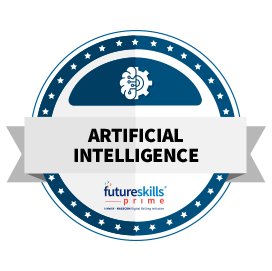Course Provider

What will you learn in this course?
You Will Learn:
- The difference between the two main types of machine learning methods: Supervised and Unsupervised
- Supervised learning algorithms, including classification and regression
- Unsupervised learning algorithms, including Clustering and Dimensionality Reduction
- How statistical modeling relates to machine learning and how to compare them
- Real-life examples of the different ways machine learning affects society
Machine Learning with Python: A Practical Introduction
-
 Skill Type
Emerging Tech
Skill Type
Emerging Tech -
 Domain
Artificial Intelligence
Domain
Artificial Intelligence -
 Course Category
Popular Tech Topics
Course Category
Popular Tech Topics -
 Certificate Earned Partner Completion Certificate
Certificate Earned Partner Completion Certificate -
-
 Course Price
INR 2,999
Course Price
INR 2,999 -
 Course Duration
9 Hours
Course Duration
9 Hours
-
Why should you take this course?
- This Machine Learning with Python course dives into the basics of Machine Learning using Python, an approachable and well-known programming language.
- You will learn about Supervised vs. Unsupervised Learning while looking into how Statistical Modeling relates to Machine Learning and will also compare them.
Who should take this course?
This course is intended for those who want to look at real-life examples of machine learning and see how it affects society in ways you may not have guessed!
Curriculum
- Module 1 - Introduction to Machine Learning
- Applications of Machine Learning
- Supervised vs Unsupervised Learning
- Python libraries suitable for Machine Learning
- Module 2 - Regression
- Linear Regression
- Model evaluation methods
- Multiple linear Regression
- Non-linear Regression
- Polynomial Regression
- Module 3 - Classification
- K-Nearest Neighbour
- Decision Trees
- Logistic Regression
- Support Vector Machines
- Model Evaluation
- Module 4 - Unsupervised Learning
- K-Means Clustering
- Hierarchical Clustering
- Density-Based Clustering
- Module 5 - Recommender Systems
- Content-based recommender systems
- Collaborative Filteringx
- Final Project
Tools you will learn in the course
IBM Watson
FAQs
Python is a popular programming language for data scientists and, more specifically, for machine learning. It has a straightforward syntax which makes it easy to learn and use. It also offers a useful approach to object-oriented programming. Plus, it has many features that are useful for dealing with arithmetic, statistics, and scientific functions.
A. Once you have completed this course, you will:
• Be familiar with machine learning terms, libraries, and the languages used to create them.
• Be able to apply the appropriate form of regression to a data set for estimation.
• Be able to apply an appropriate classification method for a particular machine learning challenge.
• Be able to use the correct clustering algorithms on different data sets.
• Be able to explain how recommendation systems work and implement one on a data set.
• Have demonstrated your understanding of machine learning in an assessed project.
This course is run by our partner SkillUp Online. It is 100% online, and you do not need to attend any classes in person. You simply require adequate access to the internet and the required technology to be able to use the course materials, which come in the form of articles, videos, and knowledge checks. Plus, you will be able to connect easily with others on the course and your mentors through the discussion space.
As soon as you enroll for this course, you will have access to all the information and materials in your dashboard.
There are no prerequisites for this course.



